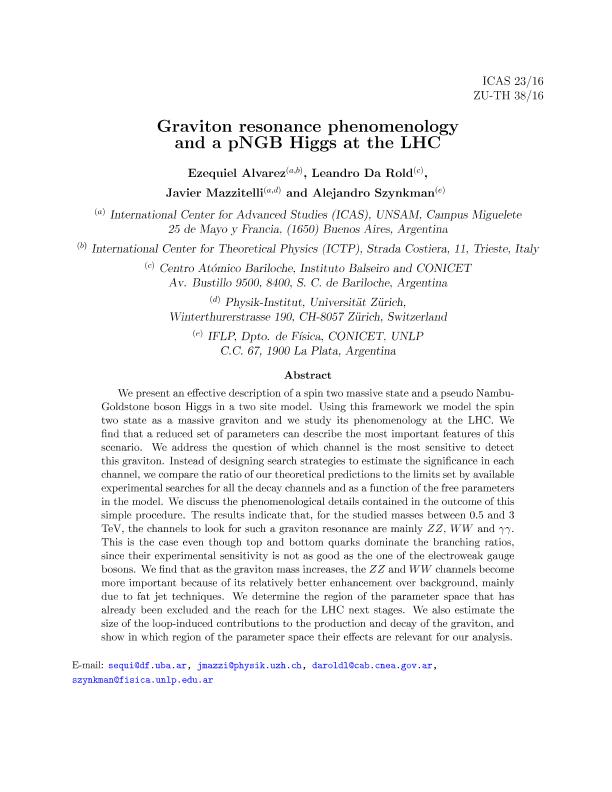Mostrar el registro sencillo del ítem
dc.contributor.author
Alvarez, Ezequiel

dc.contributor.author
Da Rold, Leandro

dc.contributor.author
Mazzitelli, Javier Sebastián

dc.contributor.author
Szynkman, Alejandro Andrés

dc.date.available
2018-10-29T18:22:19Z
dc.date.issued
2017-06-01
dc.identifier.citation
Alvarez, Ezequiel; Da Rold, Leandro; Mazzitelli, Javier Sebastián; Szynkman, Alejandro Andrés; Graviton resonance phenomenology and a pseudo-Nambu-Goldstone boson Higgs at the LHC; American Physical Society; Physical Review D; 95; 11; 1-6-2017; 1-34
dc.identifier.issn
2470-0029
dc.identifier.uri
http://hdl.handle.net/11336/63220
dc.description.abstract
We present an effective description of a spin two massive state and a pseudo-Nambu-Goldstone boson Higgs in a two site model. Using this framework, we model the spin-two state as a massive graviton and we study its phenomenology at the LHC. We find that a reduced set of parameters can describe the most important features of this scenario. We address the question of which channel is the most sensitive to detect this graviton. Instead of designing search strategies to estimate the significance in each channel, we compare the ratio of our theoretical predictions to the limits set by available experimental searches for all the decay channels and as a function of the free parameters in the model. We discuss the phenomenological details contained in the outcome of this simple procedure. The results indicate that, for the studied masses between 0.5 and 3 TeV, the channels to look for such a graviton resonance are mainly ZZ, WW, and γγ. This is the case even though top and bottom quarks dominate the branching ratios, since their experimental sensitivity is not as good as the one of the electroweak gauge bosons. We find that as the graviton mass increases, the ZZ and WW channels become more important because of its relatively better enhancement over background, mainly due to fat jet techniques. We determine the region of the parameter space that has already been excluded and the reach for the LHC next stages. We also estimate the size of the loop-induced contributions to the production and decay of the graviton, and show in which region of the parameter space their effects are relevant for our analysis.
dc.format
application/pdf
dc.language.iso
eng
dc.publisher
American Physical Society

dc.rights
info:eu-repo/semantics/openAccess
dc.rights.uri
https://creativecommons.org/licenses/by-nc-sa/2.5/ar/
dc.subject
Lhc
dc.subject
Graviton Resonance
dc.subject
Composite Models
dc.subject.classification
Astronomía

dc.subject.classification
Ciencias Físicas

dc.subject.classification
CIENCIAS NATURALES Y EXACTAS

dc.title
Graviton resonance phenomenology and a pseudo-Nambu-Goldstone boson Higgs at the LHC
dc.type
info:eu-repo/semantics/article
dc.type
info:ar-repo/semantics/artículo
dc.type
info:eu-repo/semantics/publishedVersion
dc.date.updated
2018-10-22T21:54:49Z
dc.journal.volume
95
dc.journal.number
11
dc.journal.pagination
1-34
dc.journal.pais
Estados Unidos

dc.journal.ciudad
Washington
dc.description.fil
Fil: Alvarez, Ezequiel. Universidad Nacional de San Martín. Escuela de Ciencia y Tecnología. Centro Internacional de Estudios Avanzados; Argentina. International Center for Theoretical Physics; Italia. Consejo Nacional de Investigaciones Científicas y Técnicas; Argentina
dc.description.fil
Fil: Da Rold, Leandro. Consejo Nacional de Investigaciones Científicas y Técnicas. Centro Científico Tecnológico Conicet - Patagonia Norte; Argentina. Comisión Nacional de Energía Atómica. Gerencia del Área de Energía Nuclear. Instituto Balseiro; Argentina
dc.description.fil
Fil: Mazzitelli, Javier Sebastián. Universidad Nacional de San Martín. Escuela de Ciencia y Tecnología. Centro Internacional de Estudios Avanzados; Argentina. Universitat Zurich; Suiza. Consejo Nacional de Investigaciones Científicas y Técnicas; Argentina
dc.description.fil
Fil: Szynkman, Alejandro Andrés. Consejo Nacional de Investigaciones Científicas y Técnicas. Centro Científico Tecnológico Conicet - La Plata. Instituto de Física La Plata. Universidad Nacional de La Plata. Facultad de Ciencias Exactas. Instituto de Física La Plata; Argentina
dc.journal.title
Physical Review D
dc.relation.alternativeid
info:eu-repo/semantics/altIdentifier/url/http://link.aps.org/doi/10.1103/PhysRevD.95.115012
dc.relation.alternativeid
info:eu-repo/semantics/altIdentifier/doi/http://dx.doi.org/10.1103/PhysRevD.95.115012
dc.relation.alternativeid
info:eu-repo/semantics/altIdentifier/url/https://arxiv.org/abs/1610.08451
Archivos asociados
